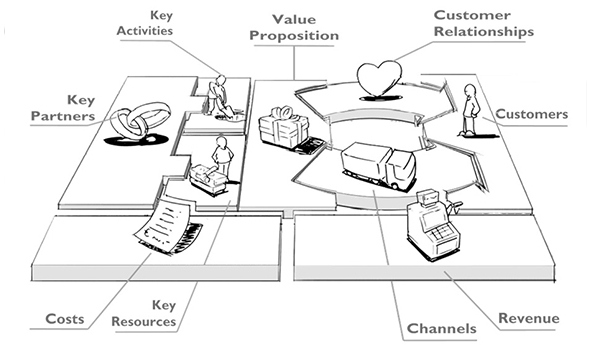
 As mentioned elsewhere on this site, I discovered the ‘Business Model Canvas’ whilst trying to figure out who my ‘customers’ are. I keep starting the process of writing about what it actually says in the book, Business Model Generation, but keep being distracted into discussions about the business of charities and the third sector (and the fourth).
As mentioned elsewhere on this site, I discovered the ‘Business Model Canvas’ whilst trying to figure out who my ‘customers’ are. I keep starting the process of writing about what it actually says in the book, Business Model Generation, but keep being distracted into discussions about the business of charities and the third sector (and the fourth).
The canvas intrigued me as it seemed to be a relatively simple way to get a complete way of working down onto a single sheet of paper. I’ve always felt that, working in the arts, whether for-profit, not-for-profit, or just not-so-profitable, that we would do ourselves well to take a ‘business-like’ approach to our work. After all, if we are on the other side from those who see people as being simply producers and consumers to feed an invisible hand, then we need to operate as effectively as we can.
So what is Business Model Generation? At first glance, it’s a bit off-putting.
A business model describes
the rationale of how an
organization creates, delivers,
and captures value
And, of course, we ask (well I do anyway), ‘What is meant by value?’ Like ‘free’ it’s a much-bandied word these days. My own understanding has always been aligned with ‘the regard that something is held to deserve; the importance, worth, or usefulness of something’ or ‘principles or standards of behaviour; one’s judgement of what is important in life’. However, these days, it seems to be more and more shackled into ‘estimate the monetary worth of.’ (All definitions from Googling ‘value’.) ‘Marketing’, it always feels, is the problem here. Doing whatever is needed to sell regardless of the real human benefit or consequences. Turning ‘wants’ into ‘needs’ to shift more product.
‘Value’ here presents a bit of a problem for me. In the quote above, it refers primarily to ‘shareholder value’, i.e. cash for the investors. However, the book is not completely about that. It is like discovering the splitting of the atom. Very interesting! Potentially bringing us to an age of unlimited energy for next to nothing … potentially sending our own species and many others to premature extinction. The book itself is neutral on the matter of ethics but does deal quite succinctly with a number of problems faced by not-for-profits, one being the idea of mission drift, as can happen when charities primarily aim to satisfy their donors and funders rather than fulfil their mission. And that does happen. I remember seeing the promotional materials of an organisation many years ago when I was fresh out of college and thinking, ‘Their promotions are all facing their funder rather than the public’. There were no such phrases as ‘mission drift’ in my vocabulary at the time but it was obvious to me that there was something wrong with the pitch.
But instead of ‘shareholder value’, we can substitute ‘stakeholder value’. And stakeholder value is, I hope, about achieving a founding mission – the reason we start something in the first place. But it gets a bit confusing because our stakeholders are both ourselves, our owners, our service-users, our customers. It turns out, in a way, that there isn’t a clear distinction between customers and owners in the case of non-profits. Particularly in the case of guarantee companies, they are set up so that shares (the guarantee) have a negative value of €1 or €2 (or IR£1.269738 if we haven’t updated our Memorandum and Articles since 2002) and thus there are no real owners other than the ‘common good’.
So in delivering stakeholder value, we are delivering value to the common good by delivering on our mission. So let’s look at that again:
A business model describes
the rationale of how an
organization creates, delivers,
and captures value
The rationale of how we create, deliver and capture stakeholder value … the rationale of how we create and deliver on our mission.
I’m still confused but what I do know is: when working on a canvas, it is well worth looking at things from two perspectives – from that of the people who benefit from the work (service users) and from that of the people who subsidise or pay for the work (funders, sponsors etc.). The value that is delivered to each is different even though they derive that value from the same product or service. In a for-profit business, shareholders put in money to derive profit. In a not-for-profit business, some stakeholders put in money to derive benefit. Where the mission, the benefit to stakeholders and the benefit to service users are well aligned, we know we’re on the right track.
